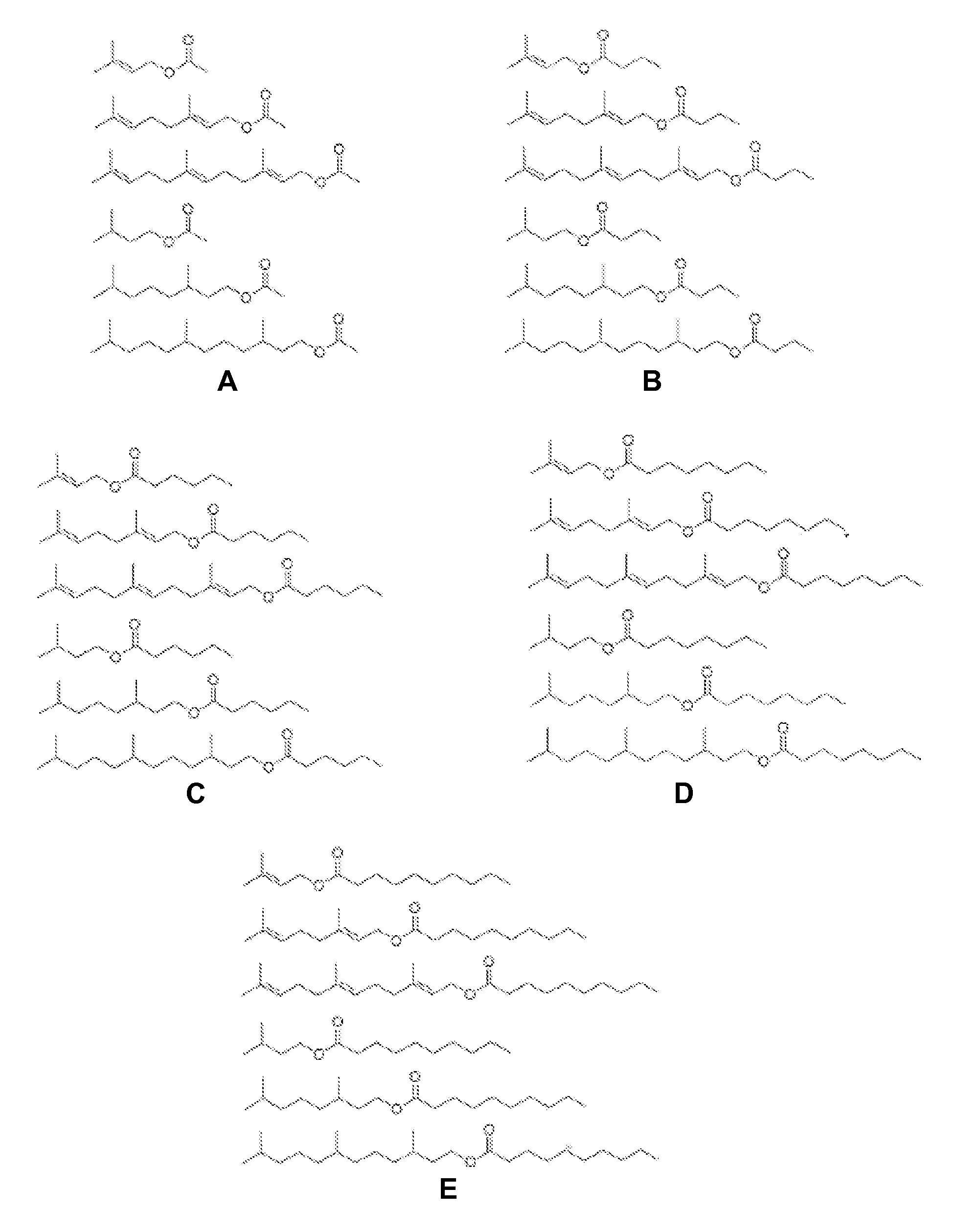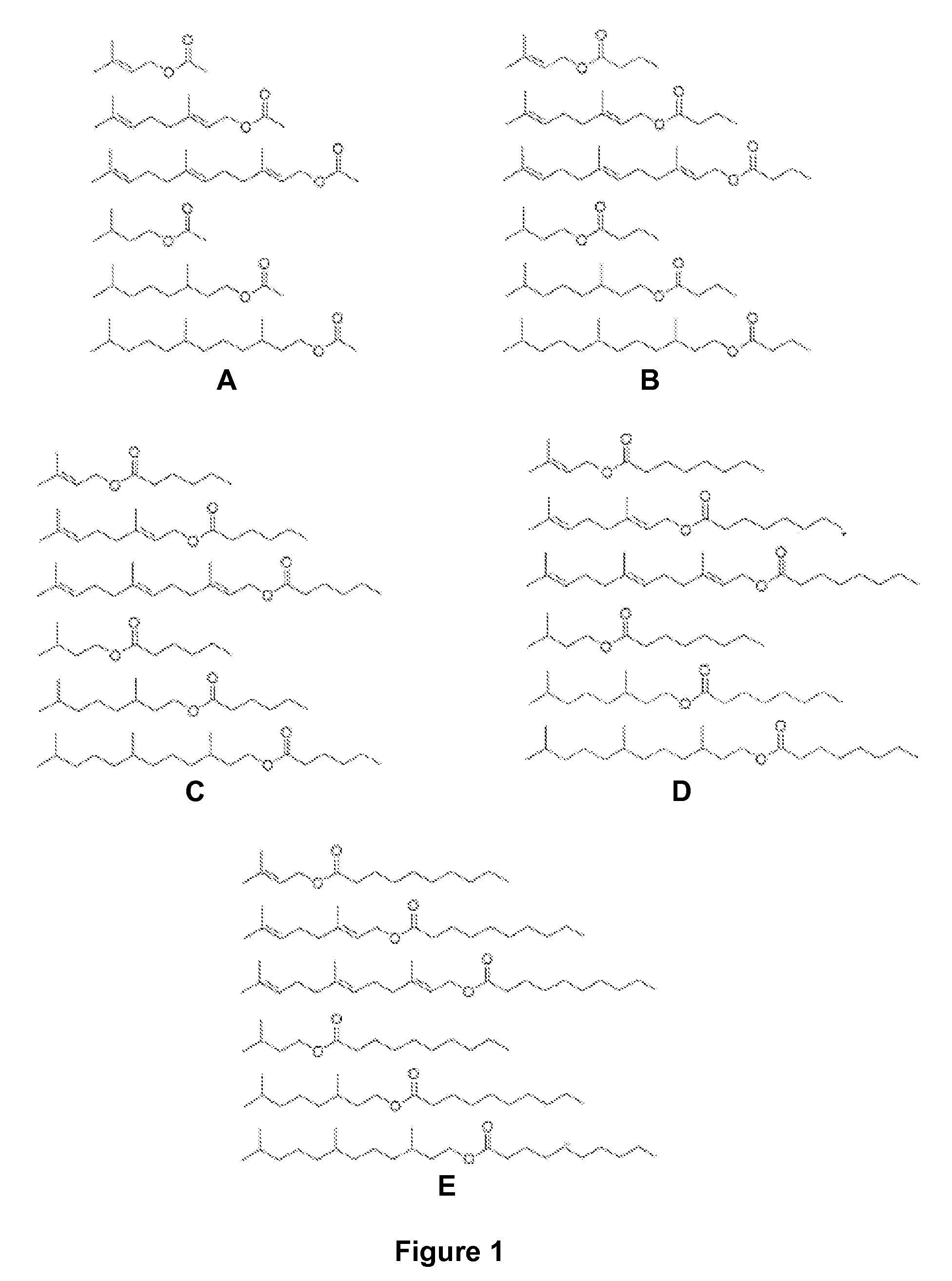Host cells and methods for producing isoprenyl alkanoates
a technology of isoprenyl alkanoate and host cells, which is applied in the direction of biochemistry apparatus and processes, microorganisms, fuels, etc., can solve the problems of not being able to meet the needs of users, and not being able to provide renewable energy
- Summary
- Abstract
- Description
- Claims
- Application Information
AI Technical Summary
Benefits of technology
Problems solved by technology
Method used
Image
Examples
example 1
Production of Isoprenyl Acetates in a Host Cell
[0088]The pMevT plasmid (containing the genes for synthesizing mevalonate from acetyl-CoA) and pMBI (containing the genes for synthesizing IPP and DMAPP from mevalonate) are introduced into E. coli DH1, which then is capable of expressing IPP and DMAPP. The method for constructing the pMevT plasmid, and nucleotide sequence, are taught in U.S. Pat. No. 7,183,089, which is incorporated in its entirety by reference. The method for constructing the pMBI plasmid is taught in Martin et al. (Nature Biotechnol. 21:796-802 (2003)), which is incorporated in its entirety by reference.
[0089]To prepare an E. coli host cell capable of geraniol synthesis, a plasmid capable of stable maintenance in E. coli and expression of the Abies grandis geranyl diphosphate synthase (AgGPPS2; the amino acid and nucleotide sequences of AgGPPS2 are taught in U.S. Application Pub. No. 2005 / 0204417, which is incorporated in its entirety by reference) or S81F-GPP mutant...
example 2
Production of Isoprenyl Alkanoates in a Host Cell
[0098]A plasmid capable of maintenance in E. coli is used to construct a plasmid capable of expressing a fatty acid synthase (FAS), such as hexanoate synthase (such as hexA and hexB of Aspergillus sp.), or elongases (such as, ELO1 (AAX70671), ELO2 (AAX70672), and ELO3 (AAX70673) from Trypanosoma), or FabA and FabB from E. coli. Further, the same plasmid, or another plasmid plasmid capable of maintaince in E. coli, is constructed to express thioesterase (TE) and acyl-CoA synthase (ACS). The TE hydrolyzes enzyme-bound fatty acid to free fatty acid, while the ACS converts the free fatty acid to fatty acid acyl-CoA.
[0099]Primers can be designed to PCR Acinetobacter calcoaceticus WS / DGAT from A. calcoaceticus genomic DNA and cloned into a suitable E. coli expression vector. The resultant plasmid is introduced into an E. coli host cell also containing the pMevT and pMBI plasmids. The resulting transformant is cultured in a suitable medium, ...
example 3
Fuel Property Test
[0106]A schematic of the synthesis of potential fuel molecules: esterification of isoprenyl alcohol and short chain fatty acyl chloride is shown below.
[0107]
[0108]Fuel property testing of potential fuel molecules was conducted using IQT (ignition quality tester) to obtain a preliminary cetane number. Cetane number prediction is based on the fuel structure and the preliminary combustion data. This analysis (FIG. 5) identified geranyl hexanoate, 3,7-dimethyloctyl hexanoate, geranyl octanoate, and 3,7-dimethyloctyl octanoate as having comparable or higher cetane numbers in comparison to commercial #2 diesel (Cetane number ˜42).
[0109]While the present invention has been described with reference to the specific embodiments thereof, it should be understood by those skilled in the art that various changes may be made and equivalents may be substituted without departing from the true spirit and scope of the invention. In addition, many modifications may be made to adapt a ...
PUM
| Property | Measurement | Unit |
|---|---|---|
| Cetane number | aaaaa | aaaaa |
| energy | aaaaa | aaaaa |
| octane number | aaaaa | aaaaa |
Abstract
Description
Claims
Application Information
 Login to View More
Login to View More - R&D
- Intellectual Property
- Life Sciences
- Materials
- Tech Scout
- Unparalleled Data Quality
- Higher Quality Content
- 60% Fewer Hallucinations
Browse by: Latest US Patents, China's latest patents, Technical Efficacy Thesaurus, Application Domain, Technology Topic, Popular Technical Reports.
© 2025 PatSnap. All rights reserved.Legal|Privacy policy|Modern Slavery Act Transparency Statement|Sitemap|About US| Contact US: help@patsnap.com



